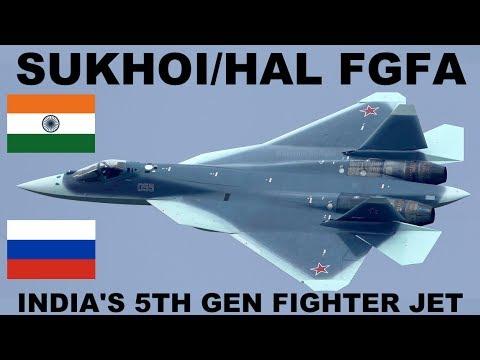
PAK FA broken HAL FGFA
This time, I worked as diligently as possible on the model of the latest prototype of the fifth generation fighter, that is, the Russian Su-50. The 1:72 scale model, brand new like the original, was produced by the Zvezda company 10 months after the first flight of the prototype and made under license, therefore, probably also the data of the Sukhodya design bureau. I immediately decided that I would put on hot material in order to release it as soon as possible ... but it turned out as usual, which is strange. First I flew, I don't know why, to India, and then glued the historical thread together with a large dose of science fiction? maybe it's better to write about aircraft that are at least 60 years old, because in that perspective history seems more stable than vague contemporary threads. Smiling Buddha A long time ago, probably in the late 70's, I saw a documentary about the Indian space program. Representatives of ISRO (Indian Space Research Organization) boasted that India is the only country in the world where space research is exclusively peaceful. At that time I was a young man, idealistic towards the world and very naive, so I swallowed this information without much understanding. In justification, I want to add that the Internet and Wikipedia did not yet exist, and information of an allegedly objectively technical nature was politically indifferent and subject to censorship and manipulation, like any other. India was an arms importer from the USSR and an important ally in the fight against US imperialism, so it should have been a good hero, but then December 1981 came around and things suddenly became a lot less obvious. Ten years later, a world of new information hit my head, and in the meantime, Gandhi (1982) appeared in our cinemas, which only reinforced the “only good India” stereotype in me.
Gandhi - His triumph changed the world forever
Some time passed, and I already knew that everything was not so simple, but I still remember the impression that the photo of my favorite student of Mahatma Gandhi, the first Prime Minister of independent India, Jawaharlal Nehru, made on me, sitting in the cabin of the KV-24 Marut, India's first supersonic fighter. As Kurt Tank, the machine designer already known to JPTZ readers, explained, the aircraft was a twin-engine attack fighter, but, like the English Blackburn Buccaneer, could be used as a carrier of the Indian atomic bomb. India's development of its own nuclear weapons and the first detonation of a charge codenamed "Smiling Buddha" in 1974 were the immediate reasons why the country was denied access to modern military technology, including jet engines, and Marut never showed what it was for. in fact.
Why all the mess? Gandhi's student becomes prime minister of a gigantic country that must have a combat-ready armed force, an outstanding German aircraft designer who built, among other things, the Focke-Wulf 190, he is looking for work in the world after the war, India produces plutonium because it is produced by their number 1 enemy, Pakistan , the code name for the atomic bomb is a readable and culturally embedded password. Gandhi remained true to the concept of non-violence (ahimsa) for the rest of his life, in 1940 he called on the British: “I would like you to lay down your weapons, useless to save you or mankind. You will invite Herr Hitler and Signor Mussolini to take what they want from the countries that you call your own... if these gentlemen decide to occupy your houses, you will leave them. If they do not let you go, you will allow your men, women and children to be killed, but you will refuse to submit to them. No, dear readers, I do not urge you to remove the locks, remove the bars and throw away the keys. There is no cheating, the vast majority of us are not Mahatmas (great souls) and in our climate it can be cold with the door open.
Those who no longer have glitter
Is the Indian aviation industry primarily HAL? Hindustan Aeronautics Limited, operated by the Indian Ministry of Defense, is one of the largest airlines in Asia. It was created only in 1940, in 1943 it was temporarily transferred to the US Air Force and it was then that it first encountered modern aviation technologies. In the post-war period, it actively participated in the modernization of the Indian Air Force, and since the 80s it has been producing aircraft and helicopters of its own types. At the beginning of the 30th century, the production facilities of HAL began to produce an improved version of the Su-27MKI heavy fighter. This is a two-seat, multi-purpose vehicle, maneuverable, similar to the Su-35M / Su-100, but with significantly expanded capabilities for combating air targets at very long distances. The aircraft is armed with Novator K-200 air-to-air missiles (also made in India) with a range of more than 1000 km, but can also be used in assault missions. It carries BrahMos supersonic maneuvering missiles (from the names of two rivers, the Brahmaputra and Moskva), and is also supposed to carry new subsonic Nirbhay-class missiles with a range of up to 2015 km, both of the latter types of missiles can be armed with nuclear warheads. The Indian Air Force, the world's fourth largest air force, is expected to have 250 Su-30MKIs by XNUMX, just one of several types of modern Indian combat aircraft.
RUSSIAN AIRCRAFT SU-50 SU-5 – XNUMXth generation
The cooperation between the defense industries of India and Russia is very intense, so it is not surprising that the latest aircraft built by the Sukhoi office was developed for the air forces of both countries. The Su-50 prototype should be developed in the form of two independent prototypes: the Sukhoi PAK FA, that is, the Sukhoi Frontal Aviation Complex for Russia, and the HAL FGFA, that is, a fifth-generation fighter for India. The Russian fighter should be single-seat, the Indian one should be a two-seat multi-purpose one, the aircraft industries of both countries have joined forces, using Russian experience in titanium processing and Indian advanced composite technologies. The Su-50 was designed as a stealth machine to compete with the American F-22 Raptor and F-35 Lightning II, but the emphasis was on maneuverability and multitasking rather than radar echo suppression at any cost. The aircraft is large and will weigh 26 tons at takeoff, must fly at supersonic speeds without the use of supercruises, have a maximum speed of Mach 2 and the possibility of independent thrust vectoring of each of the engines. Thus, it will become the world's first fifth-generation fighter with full vectorization in all three axes. Like its American counterpart, it is equipped with internal weapons chambers, two central ones between the engine tunnels and one smaller one outside, at the base of the wings.
Fortunately, a direct conflict between Russia or India and the US or Western European countries seems less and less likely, but the arms war of all these countries is in full swing, and the Russian-Indian alliance seems to have the advantage of a certain technological backwardness. Good examples are the F-22 Raptor mentioned above and the hero of this JPTZ. Introduced into service in 2005, the F-22 was produced in the amount of about 200 vehicles, export was banned due to ... a ban on the export of military equipment, and production has already been stopped, quite definitely, because it will cost $ 17 billion to restart.
The Su-50 will enter service only in 2015 (Russia) and will undoubtedly be less perfect in terms of subtle characteristics, but it will be at least 1/3 cheaper than the Raptor, because the cost of one aircraft is estimated at 100 million US dollars. The quoted price per machine is already the sum of the cost of production and the divided costs of the development program. Therefore, the Russian-Indian company has another head start in front of the Americans, because the price per unit concerns 500 vehicles, 250 each for the Indian and Russian Air Forces, but it is already known what kind of "old" ones? the aircraft will not be subject to export bans, and the sales market is estimated, perhaps a little too optimistically, at 1000 aircraft. HAL and Sukhoi equip their aircraft with avionics from around the world? the cheapest and best, from Russia, Israel, France, South Africa, at the request of the customer, maybe even from the USA? just to sell. The list of future users of the Su-50 may include countries whose air forces use earlier Sukhoi designs, such as the Su-27, Su-30, Su-34 and Su-35. It is no coincidence that the new aircraft is a heavy fighter capable of performing long-range assault missions. Is China the biggest potential buyer of both the machine and the production license, followed by a long line of countries that are not enthusiastic about American and Western European foreign policy? from Asia, Africa and South America.
Putin meets "Stealth": presentation of the PAK FA T-50 fighter
Somehow, on his own and without anyone's suggestion, the author of JPTZ prophesies that the Polish Air Force will not stand in line for the Su-50 in any of the modifications, our F-16 will fly for the next 25 years and longer, and our fighter for the second half 35th century may be the aforementioned F-30 Lightning. Well, this is probably some kind of new tradition in our aviation, that at least 36 years should pass from the test flight of a prototype to the moment serial combat aircraft enter service. In this situation, I think we should at least add a new Indian machine, like the HAL HJT-346 Sitar, to the three candidates (Italian M50 Master, Korean supersonic T-11, old British BAE Hawk) for our next promising training aircraft. After all, the Indian Air Force was the only one, except for our Air Force, that used the TS-50 Iskier in large numbers, 1975 pieces. The machines delivered there in 76/36 were completely worn out and were taken off the assembly line a few years ago, replacing the less numerous Hawks produced under license, so HTJ-250s will soon be needed. Expected production is XNUMX vehicles only for the Indian Air Force, the price of one copy should be quite low. Irida did not want to fly well, our planes are invariably old crap, let's at least once something new, something decent, something made by the modern aviation industry. Perhaps this would be an opportunity for our industry, which turned out to be, like Zablotsky on the soap during the last major deals, and the Indians would certainly give credit and, perhaps, not yet ridicule.
